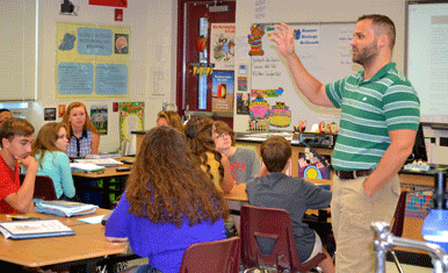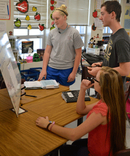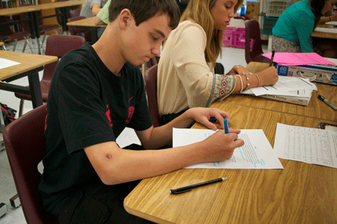Generate an Argument |

Generate an Argument
This instructional model is designed to provide an opportunity for small groups of students to develop a claim that answers a research question based on an available data set. As part of this process, groups create a tentative argument that provides this claim and the evidence that supports in a medium that can be viewed by others. Each group then has an opportunity to share their ideas during an argumentation session. These sessions are designed to create a need for students to discuss the validity or acceptability of the various arguments based on the available information. Based on the outcomes of these discussions, students refine their claims in order to better explain or describe the phenomenon under investigation. Each student is required to write out and submit a final argument to his or her teacher for the purpose of assessment. This model consists of five steps or stages:
This instructional model is designed to provide an opportunity for small groups of students to develop a claim that answers a research question based on an available data set. As part of this process, groups create a tentative argument that provides this claim and the evidence that supports in a medium that can be viewed by others. Each group then has an opportunity to share their ideas during an argumentation session. These sessions are designed to create a need for students to discuss the validity or acceptability of the various arguments based on the available information. Based on the outcomes of these discussions, students refine their claims in order to better explain or describe the phenomenon under investigation. Each student is required to write out and submit a final argument to his or her teacher for the purpose of assessment. This model consists of five steps or stages:
Stage #1: The identification of problem and the guiding question.
The teacher initiates the activity by identifying a problem to investigate and a guiding question for the students to answer. This stage of the model highlights the importance of asking questions in science.
The teacher initiates the activity by identifying a problem to investigate and a guiding question for the students to answer. This stage of the model highlights the importance of asking questions in science.
Stage #2: The generation of an initial argument
Students are given an existing data set. They then use the data they have to develop an initial argument. The argument consists of the group’s claim, the evidence they are using to support their claim, and a justification of their evidence. This stage of the model enables students to learn how to analyze and interpret data, use mathematics or computational thinking, construct explanations, and argue from evidence in science.
Students are given an existing data set. They then use the data they have to develop an initial argument. The argument consists of the group’s claim, the evidence they are using to support their claim, and a justification of their evidence. This stage of the model enables students to learn how to analyze and interpret data, use mathematics or computational thinking, construct explanations, and argue from evidence in science.

Stage #3: The argumentation session
Students are given an opportunity to share and critique their initial arguments. At the end of the argumentation session, each team has an opportunity to revise their initial argument in order to make them better. This stage of the model helps students learn how to argue from evidence and how to obtain, evaluate, and communicate information in science. It also helps students develop their communication and presentation skills.
Students are given an opportunity to share and critique their initial arguments. At the end of the argumentation session, each team has an opportunity to revise their initial argument in order to make them better. This stage of the model helps students learn how to argue from evidence and how to obtain, evaluate, and communicate information in science. It also helps students develop their communication and presentation skills.
Stage #4: A Reflective Discussion
After the teacher gives the students a chance to debrief with their group, the teacher should lead a whole class discussion. The teacher should encourage the students to explain what they learned about the phenomenon under investigation, which enables the classroom teacher to ensure the class reaches a scientifically acceptable conclusion, and think about ways to improve the nature of their arguments in the future. The teacher can also discuss any issues that were a common challenge for the groups during the second and third stage of the activity.
After the teacher gives the students a chance to debrief with their group, the teacher should lead a whole class discussion. The teacher should encourage the students to explain what they learned about the phenomenon under investigation, which enables the classroom teacher to ensure the class reaches a scientifically acceptable conclusion, and think about ways to improve the nature of their arguments in the future. The teacher can also discuss any issues that were a common challenge for the groups during the second and third stage of the activity.
|
Stage #5: The Production of a Final Written Argument
In the final stage of the model, each student is required to make sense of his or her experience by producing a final argument in writing. This stage is included in the instructional model because writing is an important part of doing science. Scientists must be able to read and understand the writing of others as well as evaluate its worth. They also must be able to share the results of their own research through writing. In addition, writing helps students learn how to articulate their thinking in a clear and concise manner, it encourages metacognition, and improves student understanding of the content. |
Learn More
To learn more about the Generate and Argument Instructional Model, see:
Sampson, V. and Gerbino, F. (2010). Two instructional models that teachers can use to promote and support scientific argumentation in the biology classroom. The American Biology Teacher, 72(7), 427-431.
Sampson, V. and Grooms, J. (2010). Generate an argument: An instructional model. The Science Teacher, 77(5), 33-37.
Sampson, V., and Schleigh, S. (2012). Scientific Argumentation in Biology: 30 classroom activities. Arlington, VA: NSTA Press.
Sampson, V. and Grooms, J. (2010). Generate an argument: An instructional model. The Science Teacher, 77(5), 33-37.
Sampson, V., and Schleigh, S. (2012). Scientific Argumentation in Biology: 30 classroom activities. Arlington, VA: NSTA Press.

